But with so many sites out there and new ones cropping up almost daily, who's got time to try them all? Playing with dozens of Web apps to find ones you like can sort of defeat the purpose of many of these services: to boost your productivity.
Fortunately for you, we've already done a lot of this work. In the collaborative Web 2.0 spirit, we're sharing some of the favorite tools we use here at Computerworld. Even with their occasional flaws, we just can't stop using them.
From a simple to-do list to a robust drag-and-drop database builder, here are the ones we've found to be borderline addictive. (But we know we might have missed some, and hope you'll post your favorites -- with URLs -- in the comments area below.)
Web apps we can't live without: | |||
The A-list | Honorable mention | ||
The A-list
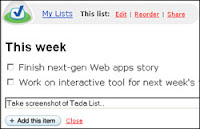 Any application has to balance the urge to offer lots of functionality with the need for an easy-to-use interface. But that's especially true for Web-based apps, where software bloat can be especially annoying because of slow connections and server wait times, and where users expect to point and click without having to read a 100-page manual first.
Any application has to balance the urge to offer lots of functionality with the need for an easy-to-use interface. But that's especially true for Web-based apps, where software bloat can be especially annoying because of slow connections and server wait times, and where users expect to point and click without having to read a 100-page manual first.You'd be hard pressed to find a more streamlined, simple service than Ta-da List, which bills itself as "the Web's easiest to-do list tool." After opening an account, click "create a new list," name it, type in a task and click "add this item." Add more items by typing them in. Order the items by clicking on "reorder" and dragging items up or down.
Done rearranging? Click "I'm done reordering." When a task is completed, click the box next to it to move it down to the bottom. Edit or delete items (or the list itself) by selecting the edit link.
That's pretty much it. There are no categories, no tags, no priority numbers. I typically use it when I've got a couple of different things in the works that I want to make sure I remember. It's simple, elegant and very quick -- easy enough to replace jotting down a list on a piece of paper, but with a cool AJAX interface.
And unlike a paper list, my Ta-da list is available anywhere I can get online; I can't misplace it. I can also share it with others, either for viewing only or as a group collaborative list. While there are Google ads on the site, they're fairly innocuous and don't feel intrusive while I'm using my list.
Ta-da List was created by 37signals, the company best known for the Basecamp project management service that spawned David Heinemeier Hansson's open-source Ruby on Rails project. Hansson is a damant about keeping all his software lean, and nowhere is that more true than Ta-da List. project. Hansson is
If you must have more functionality in a to-do list, our sister site PCWorld.com recommends RememberTheMilk as a reinvented to-do list "in a snazzy interface that lets you make lists in configurable categories, all laid out on the front page as tabs." I agree that "adding to-dos is easy, though adding deadlines, notes and time estimates is unintuitive." Overall, RememberTheMilk seems like a bit too much work for what I'd get out of it, but for those who place a higher value on functionality than on elegance and simplicity, it's worth a look.
PBwiki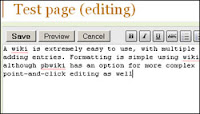 Besides giving us the Web's most famous encyclopedia, wikis offer a handy tool for many other types of informal group collaboration. A lot of open-source projects use wikis to share technical information with their users as well as among developers. While there are plenty of free wiki software packages you can download and install, in-house installation also means in-house update, patching and support.
Besides giving us the Web's most famous encyclopedia, wikis offer a handy tool for many other types of informal group collaboration. A lot of open-source projects use wikis to share technical information with their users as well as among developers. While there are plenty of free wiki software packages you can download and install, in-house installation also means in-house update, patching and support. Initially recommended to our editorial team by one of our Web developers, PBwiki has turned out to be a useful tool to share information and advice about stories in the works and future story ideas. The site claims you can "use PBwiki to make a free wiki as easily as a peanut butter sandwich," and that's pretty much accurate. And once the wiki is set up, adding pages or text to it is quicker and easier than logging into a more structured format.
PBwiki offers ad-supported free wikis as well as paid, ad-free accounts. Wikis can be public or private/shared. You can add widgets (such as basic spreadsheets, chat, Google maps or videos), with additional functionality for paid accounts. All accounts can see revision updates and changes on the site and track changes via e-mail notification. Business accounts also offer different levels of access per user, the ability to make certain pages read-only and page-level RSS feeds.
Of course, there are drawbacks to free-form data as opposed to more structured formats; you can't really query or sort a text blob. There is a basic search box in a PBwiki, but searching for "Machlis" across many wiki pages can't give you the same targeted results as, say, querying a database for "all stories by author Machlis in the last three months."
Still, if you don't expect a wiki to do the job of a spreadsheet or a database, PBwiki can be a useful addition to your information management arsenal.
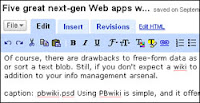 Yes, yes, I know: "Don't be evil" Google threatens to become the ubiquitous do-exactly-that Web empire, amassing too much information about individuals and too much power over what was supposed to be an egalitarian medium. Do we really want Google taking over our most-used applications, too? Perhaps not, but I can't help but like Google Docs.
Yes, yes, I know: "Don't be evil" Google threatens to become the ubiquitous do-exactly-that Web empire, amassing too much information about individuals and too much power over what was supposed to be an egalitarian medium. Do we really want Google taking over our most-used applications, too? Perhaps not, but I can't help but like Google Docs.Our recent review of four online office suites found that Google's offering lacked some important features such as spreadsheet charts. Unlike some, though, I'm not seeking to replace my desktop word processor or Microsoft Excel (by far my favorite spreadsheet). Instead, I see a good online suite as adding features such as file-sharing or online backup to my existing text editors and spreadsheet app.
Google Docs offers an easy way to work on documents at home, at the office and elsewhere, without having to e-mail files around. I keep some simple documents in Google Docs and download backups to my own PC. When I want the power-user functions of Word or Excel, I can work in those packages, upload the file to Google Docs and then download again to my next system before starting to work again. It's a version control system for documents and spreadsheets.
In fact, I'm writing this story now in a Google Doc document. I don't need slick formatting, headers and scripts; basic writing, HTML coding and spell-check works just fine. However, when it comes time to turn it in, I'll be downloading it to my own system, saving it as a Word doc and e-mailing the file to my editor, since she's partial to Word's "track changes" function, which I must admit is more elegant than Google Doc's "compare revisions."
Still, comparing revisions is a nice function to have, along with some formatting, quick-link additions and sharing. And I've got a backup copy somewhere I can easily access if I want to make changes at home and then e-mail a new file.
Google's spreadsheet definitely isn't powerful enough for some of my projects. (A personal task analyzing local pedestrian accidents had too much data, for example.) However, it's fine for moderate strength tracking needs and superior when I want multiple users adding fairly simple data to a sheet. It's baffling that Microsoft hasn't jumped into the business of offering a Web platform for easily sharing Excel documents, although others such as eXpresso Corp. are trying to get into that business.
Meanwhile, I'm finding Google Docs a nice backup and version-control server for important and useful but not terribly private or sensitive documents.
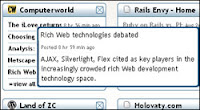 There are loads of RSS readers out there, including worthy entries like NewsGator and Google Reader, as well as some with Web 2.0 interfaces on steroids, such as Pageflakes.
There are loads of RSS readers out there, including worthy entries like NewsGator and Google Reader, as well as some with Web 2.0 interfaces on steroids, such as Pageflakes.But over the years, I kept returning to Bloglines, despite its aging Web 1.0 interface, because it did what I wanted done with a minimum of fuss. Finally, though, the new Bloglines v3 beta offers an updated UI with a start page and some drag-and-drop ordering that brings the RSS service into the modern era.
My goal in reading RSS feeds isn't to recreate a full, rich-media Web experience. If I wanted that, I'd be surfing directly to source sites. Instead, I want to scan headlines and summaries. I don't want to play around with a lot of buttons, links and options; I'm looking for information.
I want simple ways to subscribe to feeds and see what's new, with some basic feed organization tools. I want to be able to import and export OPML (a way to save a collection of feed subscriptions). And being able to "clip" and save individual stories is nice.
The beta was pretty limited when I started testing, without even a way to mark posts as still unread (that's since been addressed with a "pin" function). I'm still awaiting the "clippings" (keep and save some items) and "publish" (mark items to put in a new RSS feed you can make public) options, but the Bloglines beta help pages assure such functions are on the way.
The start page shows you summaries of headlines when you hover over the item, an AJAX standard that's just coming to Bloglines, and lets you easily add, delete and rearrange components.
The only major annoyance so far is that when I click on links from my start page, I just get a Bloglines summary pop-up instead of going to the source site; for that, I've got to move my mouse over to the pop-up window and click a second time. I'd prefer a summary when hovering but a link when I click.
Overall, though, it's looking like the Bloglines update will refresh but not mess with the basic functionalities that have won the service a place near the top of my browser bookmarks.
Zoho Creator Unlike word processors or wikis, I haven't seen a flood of free Web sites for building database-driven applications. The few other database entries I'd tried were generally either limited, expensive or cumbersome. But not Zoho Creator.
Unlike word processors or wikis, I haven't seen a flood of free Web sites for building database-driven applications. The few other database entries I'd tried were generally either limited, expensive or cumbersome. But not Zoho Creator.
Zoho Creator sports a surprisingly easy interface for creating your own apps -- even those that include some table joins (that is, looking up information in one table for use in another, which puts the "relational" in relational databases). With a few drag-and-drops, I quickly created data entry forms with text fields, drop-down lists, text boxes and so on.
My test applications ranged from simple (tracking charitable contributions) to complex (story tracking by writer, editor and status), and all ended up doing pretty much what I wanted.
One database collects all Computerworld product reviews published this year. You can see the live interactive database below. Sort by any of the available columns by clicking on the column header (clicking the same header toggles between ascending and descending sort). Click on the search box, and you'll see options to search by product name as well as headline and date.
There's a drag-and-drop option for adding a "lookup" field that pulls selections from another table. It's likewise fairly easy to set up different views of your data, and user-by-user access to each view and form. Creator also offers drag-and-drop scripting, allowing such things as setting defaults or variables based on certain conditions, sending out autogenerated e-mails when a field is changed in a specific way, or validating user input.
For more sophisticated scripting, it's easy to click back and forth between drag-and-drop scripting and the actual code. And I quickly downloaded data from Zoho Creator onto my own system for backup in varying formats, such as comma-separated or XLS spreadsheet format (although, alas, not in SQL) -- a must for any Web-based application where I'm storing important data.
I showed some of my colleagues the sample story-tracking app I put together on Creator, and response was highly favorable. I can think of many real-world uses for Creator, from detailed story tracking in our newsroom to keeping the list of who's slated to buy Friday morning donuts (making it simple to see who hasn't bought their share and even set up automated e-mail notifications when the list is changed). If you're a fan of structured data on the Web, both available to the public at large and shared with a select list of friends or colleagues, Zoho Creator is definitely worth a look.
Be aware that if you're a true database geek, Zoho Creator isn't a replacement for coding your own database app with something like PHP, Python or Ruby, and MySQL or PostgreSQL. Page layouts are limited (there are two, with no style customizations), and you can't do everything with variables, conditional scripting or sophisticated table joins that you can when coding from scratch. (I was told, for example, that I couldn't use a variable value as part of the name of my view.)
You can embed Zoho Creator applications in your own Web pages, although if you decide to use the apps at Zoho.com, you can't do things such as redirect users to a specific view after they've filled out a form. (They just get a message saying data was successfully submitted, followed by a new blank form.)
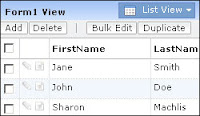
And while most of the application is intuitive, some things are not, such as how to store a "collection" of records and even how to edit existing records (a puzzle shared by several of my colleagues, although easy to use once we found it -- a barely noticeable pencil icon next to records in a view).
Fortunately, though, the Zoho staff is quite responsive about answering questions, even from customers with free accounts. Some of the written responses can be a bit difficult to understand, but they're generally useful. In one case, someone even built me a sample application to demonstrate how to conditionally pull data from one table into another.
Zoho.com has a slew of other offerings, including word processing, spreadsheets, wikis, project management, "notebooks" and Web conferencing, although so far I've stuck with Creator. Many of the other apps, including the Google Docs competitors Zoho Writer and Zoho Sheet, are quite feature-packed, but too much at the expense of elegant UI for my tastes.
Earlier this month, Zoho announced a private beta of Zoho Business, a pay service that will include a companywide administrative console, telephone support and "co-branding." For now, most of the services are free, and the plan is to keep them so for individual use. I expect I'll be building some real apps on the site soon.


1 comments:
Hello. This post is likeable, and your blog is very interesting, congratulations :-). I will add in my blogroll =)THANX FOR
MAKING SUCH A COOL BLOG
Let me share with you a great resource,
Free Resume Examples
A collection of Free Resume Examples. This site have great Free resume format examples covers all professions of life with exact details and techniques as how to write professional looking resumes.sa
Post a Comment